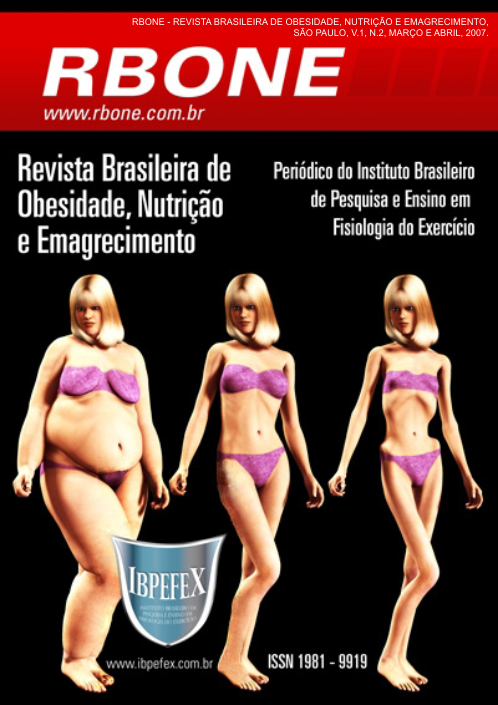Nutritional and the physical activity level the high school students from a public and private school
Abstract
This study has the purpose of comparing the nutritional and the physical activity level the high school students from a public and private school. Weight, height, physical activity characteristics and eating habits were determined through questionnaires. The diagnosis of the nutritional condition was taken from the body mass index, according to the World Health Organization. In the private school, it was identified 63% of overweight and 11% of obesity, whilst in the public school 26% of obesity and 30% of overweight. It was observed that among volunteers of both genders in the public school, the prevalence of sports practice was higher (male [M] 76% and female [F] 42%) than in the private school (25% [M] and 34% [F]), as opposed to those who don’t exercise was met in the private school 39% [M], 5% [F] and 15% [M], 16% [F] in the public school. During leisure time, we verified that 68% of female volunteers from the public school watches TV and 50% in the private school use the internet. Among the volunteers, there was a prevalence of several types of activities in both schools. It was observed in the both schools, of 50% intake of fish, and more than 80% of vegetables and fruits. In the family disease, it was observed more than 50% of volunteers showed history of diabetes while the hypertension and obesity were higher in the public school (34,17% and 35,44%), when compared with the values of the private school (26% and 17, 39%). This result permit to conclude that there is a need for better nutritional orientation and the practice of physical activity by both adolescents and their families.
References
- Abrantes, M.M.; Lamounier, J.A.; Colosimo, E.A. Prevalência de Sobrepeso e Obesidade nas Regiões Nordeste e Sudeste do Brasil. Revista da Associação Médica Brasileira. n°49. p. 162-6. 2003.
- Bouchard, C. Atividade Física e Obesidade. 1a edição. São Paulo. Manole. 2003.
- Conti, M.A.; Fructuoso, M.F.P.; Gambardella, A.M.D. Excesso de Peso e Insatisfação Corporal em Adolescentes. Revista de Nutrição. Campinas. n° 18 p. 491-7. 2005.
- Dâmaso, A. Obesidade. Rio de Janeiro. Editora Médica e Científica Ltda – MEDSI. 2003.
- Dâmaso, A.; Bernardes, D.; Cheik, N.C. Morfologia do Tecido Adiposo. Obesidade. Rio de Janeiro. Editora Médica e Cinetífica Ltda – MEDSI. 2003.
- Estadella, D.; Habitante, A.C.; Oyama, L.M.; Nascimento, C.M.O. Exercício Físico e Dieta de Cafeteria. Obesidade. Rio de Janeiro. Editora Médica e Científica ltda – MEDSI. cap. 18. p. 305-318. 2003.
- Fonseca, V.M.; Sichieni, R.; Veiga, G.V. Fontes Associadas à Obesidade em Adolescentes. Revista Saúde Pública. n. 32. p. 541-9. 1998.
- Gambardella, A.M.D.; Frutuoso, M.F.P.; Franch, C. Pratica Alimentar de Adolescentes. Revista de Nutrição. Campinas. n. 1. vol.12. 1999.
- Halpern, Z.S.C.; Rodrigues, M.D.B. Síndrome Metabólica na Infância e Adolescência. Síndrome Metabólica. São Paulo. Atheneu. Cap. 21 p. 239-246. 2005.
- McArdle, W.D.; Katch, F.I.; Katch, V.L. Fisiologia do Exercício – Energia, Nutrição e Desempenho Humano. 5a edição. Rio de Janeiro. Guanabara Koogan. 2003.
- Mendonça, C.P.; Anjos, L.A. Aspectos das Práticas Alimentares e da Atividade Física como Determinantes do Crescimento do Sobrepeso/Obesidade noBrasil. Caderno Saúde Pública. Rio de Janeiro. n. 20. p. 698-709. 2004.
- Monteiro, P.O.A.; Victoria, C.G.; Barros, F.C.; Tomasi, E. Diagnóstico de Sobrepeso em Adolescentes: Estudo do Desempenho de Diferentes Critérios para o Índice de Massa Corporal. Revista Saúde Pública. n. 34. p. 506-13. 2000.
- Must, A.; Dallel, G.E.; Dietz, W.H. Reference Data Obesity: 85 and 95 percentiles of Body Mass Index (wt/ht2) and Triceps Skin fold Thickness. American Journal Clinical Nutrition. n. 53. p. 839-46. 1991.
- Nahás, M.V. Atividade Física, Saúde e Qualidade de Vida: Conceitos e Sugestões para um Estilo de Vida mais Ativo. Londrina. Midiograf. 2001.
- Silva, G.A.P.; Balaban, G.; Motta, M.E. Prevalência de Sobrepeso e Obesidade em Crianças e Adolescentes de Diferentes Condições Socioeconônicas. Revista Brasileira Saúde Materno Infantil. Recife. n. 5. p. 53-59. 2005.
- Oliveira, C.L.; Mello, M.T.; Cintra, I.P.; Fisberg, M. Obesidade e Síndrome Metabólica na Infância e Adolescência. Revista de Nutrição. Campinas. n. 17. p. 237-245. 2004.
- Oliveira, E.A.J.; Vittale, M.S.S.; Amâncio, O.M.S. Estado Nutricional no Estirão Pubertário. Departamento de Pediatria da Universidade Federal de São Paulo. Escola Paulista de Medicina (UNIFESP/EPM). São Paulo. 2000.
- Veiga, G.V.; Dias, P.C.; Anjos, L.A. A Comparison of Distribution Curves of Body Mass Index from Brazil and the United States for Assessing Overweight and Obesity in Brazilian Adolescents. Revista Panamericana de Saúde Pública. n° 10. p. 79-85. 2001.
- Wang, Y.; Monteiro, C.A.; Popkin, B.M. Trends of Obesity and Underweight in Older Children and Adolescents in the United States, Brazil, China, and Russia. American Journal Clinical Nutrition. n° 75. p. 971-7. 2002.
- Wilmore, J.H.; Costill, D.L. Fisiologia do Esporte e do Exercício. 1a edição. São Paulo. Manole. 2001.
Authors who publish in this journal agree to the following terms:
- Authors retain the copyright and grant the journal the right of first publication, with work simultaneously licensed under the Creative Commons Attribution License BY-NC which allows the sharing of the work with acknowledgment of the authorship of the work and initial publication in this journal.
- Authors are authorized to enter into additional contracts separately for non-exclusive distribution of the version of the work published in this journal (eg, publishing in institutional repository or book chapter), with acknowledgment of authorship and initial publication in this journal.
- Authors are allowed and encouraged to post and distribute their work online (eg, in institutional repositories or on their personal page) at any point before or during the editorial process, as this can bring about productive change as well as increase impact and impact. citation of published work (See The Effect of Free Access).






